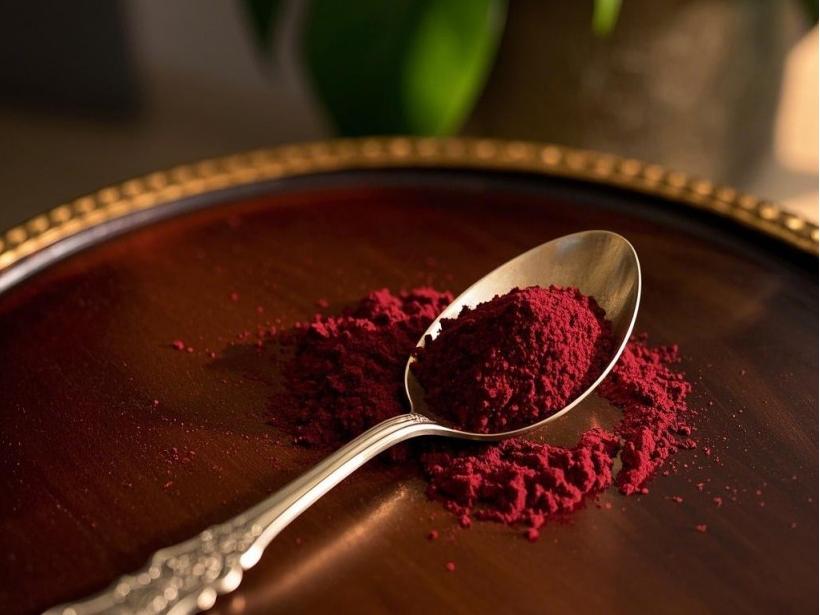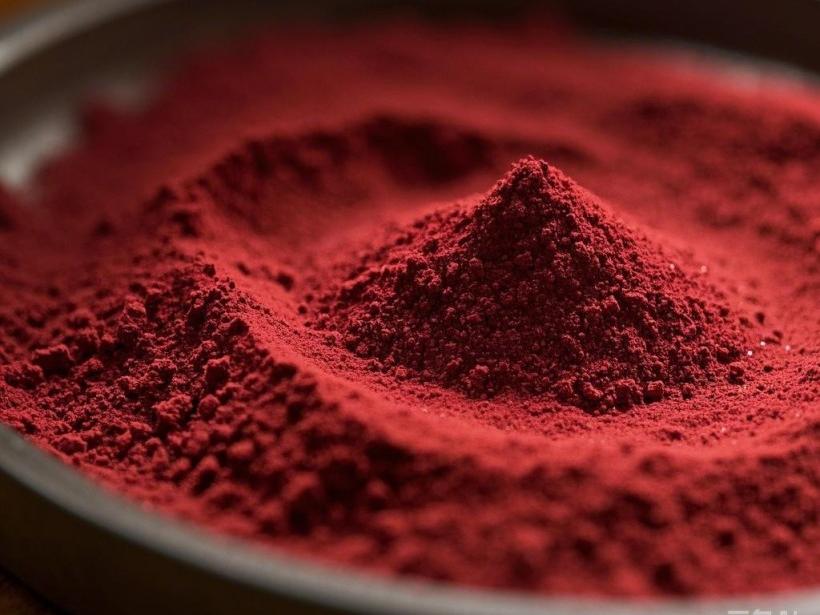リコペンって何?
リコピンis a natural carotenoid that is found mainly in ripe tomatoes, watermelons, guavas, rose hips, papayas, and grapefruits [1]。 In addition, marine halophilic archaea can also produce lycopene [2]. The human body cannot synthesize lycopene on its own, and 85% of its intake comes from tomatoes and tomato-based products [3]. In the past few decades, functional research on lycopene has focused on its antioxidant, lipid-lowering, anti-inflammatory, and anti-tumまたはproperties [4-7].
people&として#39;s awareness of food safety has gradually increased, some natural plant extracts have become the focus of research in the context of antibiotic-free farming. Lycopene has advantages in improving animal health and enhancing the quality of animal products, making it a natural plant additive with great potential [8-9]. However, at this stage, the amount added and the effect of lycopene in the breeding of different types of animals are not consistent, and the mechanism of action is not yet clear, so the degree of application and promotion is not high. In this paper, the physical and chemical properties, safety, biological functions and application progress of lycopene in animal productionリコピンのさらなる研究と利用のための参照を提供するために、レビューされています。
1 .リコピンの物理的・化学的性質と安全性
1.1物理的および化学的性質
Lycopene is a fat-soluble carotenoid that belongs to the isoprene unsaturated alkenes. It has 11 conjugated double bonds and 2 non-conjugated double bonds, with a molecular formula of C40H56 and a relative molecular mass of 536.85. It has a melting point of 172–175°C and is a dark red powder. It is soluble in chloroform, hexane, benzene, carbon disulfide, acetone, petroleum ether and petroleum, insoluble in water, ethanol and methanol, sensitive to light, oxygen, high temperature, acid, catalyst and metal ions [10]. Among all carotenoids, lycopene has the highest degree of unsaturation. It mainly exists in the all-trans configuration in natural fruits and vegetables, but is easily oxidized and degraded and undergoes isomerization under the influence of heat and light [11].
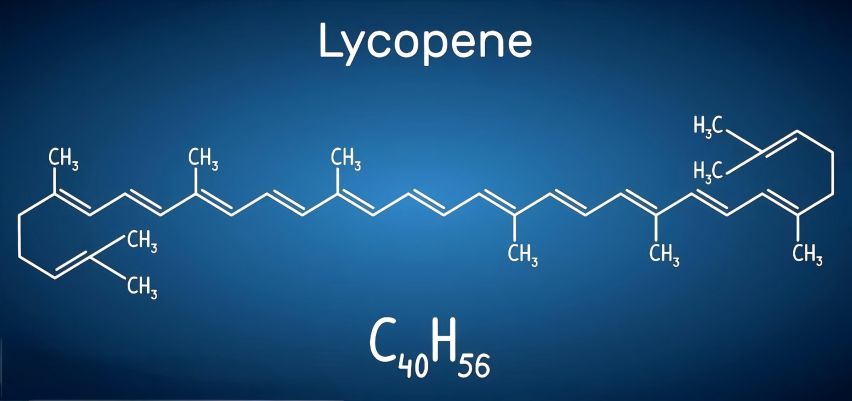
1.2リコピンの安全性
Lycopene has a long history of safe consumption worldwide. Perucatti et al. [12] showed that a diet rich in lycopene does not produce any mutagenic activity and is not toxic to rabbit lymphocytes. Lycopene has low acute toxicity in mice, and 3 g/kg body weight of lycopene administered orally and intraperitoneally has no effect on mice [13]. Moreover, no significant systemic toxicity was observed in subchronic and chronic safety studies [14]. Therefore, lycopene is considered to be a safe and non-toxic substance.
2. リコピンの生理機能
2.1抗酸化机能
酸化ストレスは多くの疾患を引き起こす主な要因の一つと考えられています。リコピンは、抗酸化作用による酸化ストレスの損傷を緩和し、それによって動物の健康を改善することができます。
2.1.1フリーラジカルの直接掃討
Lycopene has 11 conjugated double bonds and is highly reactive with oxygen and free radicals [15]. Lycopene is the most effective antioxidant among the various common carotenoids [16], and its rate constant for singlet oxygen scavenging is twice that of β-carotene [17]. In addition, lycopene can in vitro and intracellularly scavenge peroxynitrite [18-19]. Mortensen et al. [20]showed that lycopene has the ability to scavenge nitrogen dioxide and sulfuryl and sulfuryl radicals. Galano et al. [21] reported that lycopene is more efficient than carotene in scavenging hydrogen peroxide radicals in non-polar environments.
2.1.2抗酸化系の活性を高める
Lycopene can indirectly affect free radicals by regulating the production of antioxidant enzymes, thereby protecting the body from oxidative damage. Studies have shown that in a rat model of type 2 diabetes, lycopene significantly increased the activity of superoxide dismutase (SOD), glutathione peroxidase (GSH-Px) and catalase (CAT) [22-23]. Li Li [24] explored the intervention effect of lycopene on esophageal cancer in rats and found that after lycopene intervention, the enzyme activities of GSH-Px and SOD in rat serum increased significantly, while the level of malondialdehyde (MDA) decreased, improving the oxidative stress state of esophageal cancer rats. In addition, lycopene can increase the body'の非酵素的な抗酸化コンテンツ。ウサギの食事にリコピンを加えると、ビタミンaおよびeの血中濃度が有意に上昇し、酸化剤の濃度が有意に低下する[25]。sahinら[26]は、熱ストレスを受けたウズラの食事をリコピンで補ったところ、ビタミンa、ビタミンc、およびビタミンeの血清レベルが上昇し、ウズラの熱ストレスによる酸化ストレスが緩和され、ウズラによる抗酸化物質の消費が減少したことを発見した。
現在、生体内での酸化ストレスによるダメージを、リコピンが軽減する仕組みは、主にin vivoで解明されています。核因子エリスロイド2関連因子2 (nrf2)は、酸化ストレスから細胞を守る抗酸化ストレス応答における重要な転写因子である[27]。nrf2は、ヘムオキシゲナーゼ-1 (ho-1)、nad (p) h: quinone oxidoreductase 1 (nqo-1)、sodおよびグルタチオンs-転移酵素(gst)などの一連の薬物代謝酵素および細胞保護酵素の発現を仲介し、内因性および外因性酸化物質(活性酸素種など)の除去と解毒を促進する[28]。
Studies have shown that lycopene significantly activates the mRNA expression of the antioxidant enzymes HO-1 and NQO-1 in the hippocampus of rats, which can reduce oxidative damage by activating the Nrf2 signaling pathway [29]. Similarly, Zhao et al. [30] found that lycopene increased antioxidant capacity by mediating the Nrf2 signaling pathway, thereby suppressing oxidative stress induced by phthalic acid (2-ethylhexyl ester) in mouse mesenchymal cell damage. In summary, lycopene can directly scavenge or inhibit free radicals, and it can also act as an inducer to activate antioxidant signaling pathways, enhance the activity of the body'の抗酸化システム、および酸化ストレス損傷を緩和し、動物の健康を保護するために、様々なメカニズムを通じて抗酸化機能を発揮します。
2.2 Lipid-lowering機能
Lycopene can regulate lipid metabolism and lower blood lipid levels. In a rat model with a high-fat diet, lycopene supplementation significantly reduced the levels of total cholesterol (TC), triglycerides (TG), low-density lipoprotein cholesterol (LDL-C) and oxidized low-density lipoprotein (Ox-LDL) in the serum and brain [31]. Similarly, lycopene reduced the serum TC, TG, LDL-C and liver TC and TG levels in diabetic rats [22]. In vitro studies have shown that lycopene binds to the hydrophobic part of 3-hydroxy-3-methylglutaryl coenzyme A (HMG-CoA) reductase, competitively inhibiting HMG-CoA reductase activity [32] and thereby reducing cholesterol synthesis. In addition, research by Fenni et al. [33] showed that lycopene can reduce the gene expression of sterol regulatory element binding protein (SREBP-1c) and fatty acid synthase (FASN) in mice with diet-induced obesity, and upregulate the expression of three genes related to fatty acid oxidation. Therefore, the lipid-lowering function of lycopene may be related to its ability to inhibit the activity of the rate-limiting enzyme in cholesterol synthesis and enhance the β-oxidation of fatty acids.
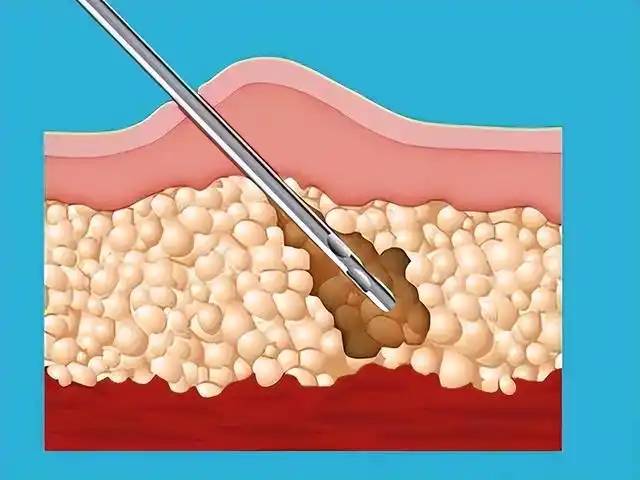
2.3消炎機能
Lycopene has an anti-inflammatory function, which can improve liver inflammation in mice with non-alcoholic fatty liver disease [34] and reduce the level of inflammatory factors in prostate cancer cells [35]. Yang et al. [36] found that lycopene significantly reduced the expression of matrix metalloproteinase-13 (MMP-13), serum interleukin 6 (IL-6) and tumor necrosis factor α (TNF-α) in human osteoarthritis articular chondrocyte cells, and played a protective role. The mechanism may be through activation of the Kelch-like epoxyeicosatrienoic acid-related protein-1 (Keap1)-Nrf2 signaling pathway. Similarly, Sun et al. [37] showed that lycopene reduced the expression of TNF-α, IL-6 and IL-1β in H2O2-induced bovine mammary epithelial cells. The mechanism may be through inactivation of the nuclear factor-κB (NF-κB) signaling pathway, thereby reducing the expression of pro-inflammatory cytokines.
他の研究も同じ結果を報じリコピンが大幅に血清がレベルのIL-2やインターフェロンγ(IFN -γ)とTNF - IL-2のαと表われmRNA、IFN -γとTNF -浴びて过ごしたマウスのαのを見損なっをアフラトキシンB1 (AFB1)が解消しAFB 1-induced immunosuppression酸化を抑えることでストレスとアポトーシスをmitochondrial-mediatedマウスsplenocytes[38]。炎症反応を抑制するリコピン主要約の活性化を防ぐという点でNF -κBシグナリング経路や炎症の生産のアジャスターの制限がキム・イルソン)からTNF -αなど
2.4抗がん機能
これまでの研究で、リコペンは前立腺がん、乳がん、胃がん、肺がん、大腸がんのリスク低下に関連していることが示されている[39]。リコピン抑止効果がある発癌機転先週食道ネズミ粘膜の内視鏡そしてそれはヘロウリングにup-regulating peroxisomeの表情proliferator-activated受容体γ(燃やす働きγ)とcysteine-aspartic酸protease-3 (Caspase-3)タンパク質表情、downregulating NF -κBとcyclooxygenase-2(剤)の表情タンパク質に食道癌のため発生を抑制する。のmedium-doseトマトの红素食道がんに対する介入群(体重25 mg/kg)の阻害効果が最も高かった[24]。また、肺がん誘導のモデルとたばこNNK発がん物質の人は、リコピンは肺がん细胞拡散を防ぐ抑制員に発見され肺の表情はα7 nicotinicムスカリン受容体とその下流たんぱく質[40]。リコピンの抗がん作用に関する現在の研究は非常に有望であるが、臨床現場での作用機序に関する研究は一般的に不足しており、科学研究者によってさらに深く探求される必要がある。
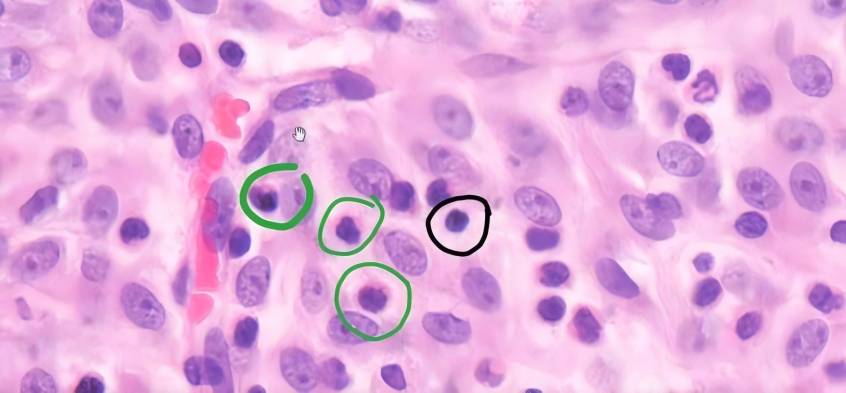
2.5骨粗しょう症を抑える
Studies have shown that the higher the lycopene level in the serum of Chinese women, the higher their bone mineral density [41]. At the cellular level, lycopene has been shown to inhibit the differentiation of osteoclasts and stimulate the proliferation and differentiation of osteoblasts [42]. The mechanism may be the direct effect of lycopene on the mitogen-activated extracellular signal-regulated kinase (MEK) and protein kinase C (PKC) pathways during osteoclast formation and on MEK and NF-κB during osteoblast formation [43].
3 .リコピンの動物生産への応用
3.1鶏肉生産におけるリコピンの応用
リコピン粉can improve poultry performance, improve egg quality, reduce heat stress damage, and improve reproductive performance. Sun et al. [44] found that adding 40 mg/kg lycopene to the diet of laying hens can significantly increase the initial weight and antioxidant capacity of broiler chicks. と述べ lycopene (10 and 20 mg/kg) to the feed of laying hens can increase the lycopene content in the liver and egg yolk, while reducing the MDA content in the serum and eggs stored for 4 weeks [45]. Studies have shown that adding 200 mg/kg lycopene to the feed can reduce the serum TC and TG content of laying hens, as well as the cholesterol content of the liver, egg yolk, and breast muscle [46].
Sahin et al. [26] added 50, 100, and 200 mg/kg lycopene to the diets of quails under heat stress (34 °C), and found that it could improve the feed conversion rate and carcass weight of heat-stressed quails. Subsequent research by Sahin et al. [47] showed that the addition of lycopene (200 and 400 mg/kg) to the feed can alleviate the symptoms of heat stress in broilers, as lycopene increases the expression of the Nrf2 gene in the muscle and the activity of antioxidant enzymes (SOD, GSH-Px) in the serum. Najafi et al. [48] showed that lycopene can improve the total motility, membrane integrity and mitochondrial activity of frozen-thawed rooster sperm, as well as the hatchability of fertilized eggs from artificial insemination. At present, the additive amount of lycopene in poultry feed ranges from a few tens to a few hundreds of milligrams, and the experimental groups are small, so further research is needed to determine the optimal additive amount in large groups.
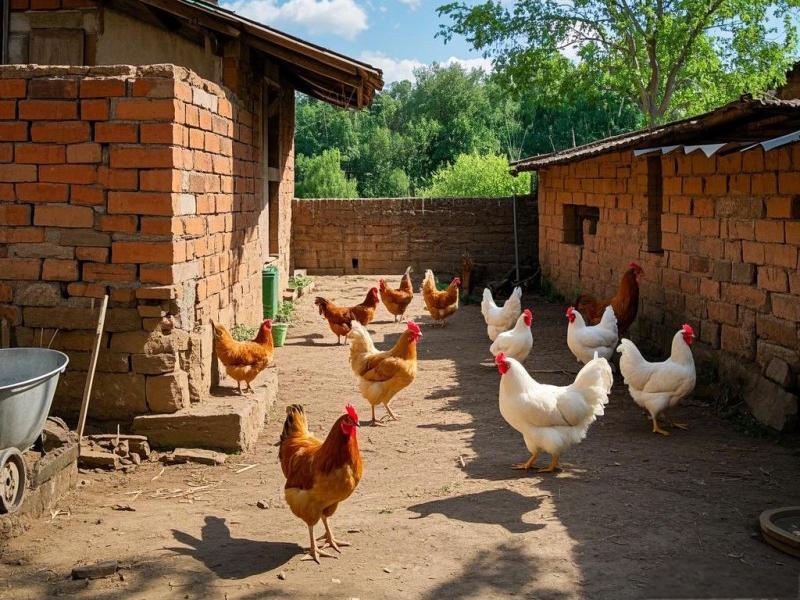
3.2反芻動物の生産におけるリコピン
Adding lycopene powder to the feed can improve the growth and development and meat quality of Bamei mutton sheep in hot summer environments [49]. Xu et al. [50] showed that the addition of 200 mg/kg and 400 mg/kg lycopene to the feed of lake sheep could increase the colour stability and the content of antioxidant substances (vitamin A and vitamin E) in the stored mutton, and reduce the degree of lipid and protein oxidation. In addition, lycopene can significantly improve the mitochondrial activity of bull sperm after thawing [51], and can also improve the quality of cattle embryos cultured in vitro [52]. Ren et al. [53] showed that the addition of 1.0 mg/mL lycopene to the cryopreserved cashmere goat semen significantly improved sperm motility, acrosome integrity, mitochondrial activity, and the activity of antioxidant enzymes in goat sperm.
The group with 4.0 mg/mL lycopene did not improve the physiological characteristics of the sperm. Tvrdá et al. [54] showed that In a model of oxidative stress damage induced by ferrous ascorbate in bovine sperm, the addition of lycopene (0.25, 0.50, 1.00, 2.00 mmol/L) can improve sperm activity and significantly inhibit the increase in MDA in the sperm suspension. The most effective lycopene concentrations are 1.00 and 2.00 mmol/L. The mechanism may be that lycopene can easily pass through biological membranes and quickly enter cells, playing an important role in protecting cell membranes and lipoproteins from oxidative damage. The above results show that lycopene has the effect of improving the production performance of ruminants, improving the quality of stored lamb, and improving the quality of sperm from breeding animals. In order to achieve the best application results, attention should be paid to the amount of additive during the application process.

3.3豚の生産におけるリコピンの応用
There are few reports on the use of lycopene in pig production。王潔[55]一定付け加える集中力を発揮しリコピン大幅に冻れる豚精子はの希釈精子の質を向上させ、解凍後、風味が最适、数値は2.0μmol / L。研究では、豚の飼料に20 mg/kgのリコピンを添加すると、新鮮な豚肉のmda含有量が減少することが示されています[56]。リコピン(12.5、25.0、37.5、50 mg/kg)を飼料に添加すると、貯蔵中の豚肉のmda含有量を減少させることができ(0、24、48、72時間)、最も効果が得られるのはリコピンの添加が50 mg/kgである[57]。そのメカニズムは、肉のリコピン含有量を増加させ、それによって豚肉の酸化安定性を向上させることであると考えられている。さらに、correia et al.[58]は、ピグレットに5%のトマトポマースを加えることを発見しました'飼料の内容を増やすことも可能ですα筋肉中-tocopherolし、豚肝臓や教育の質を向上。
3.4水生動物のリコピン
Lycopene has the effect of improving the production performance of aquatic animals and reducing oxidative stress damage. Adding 0.2% lycopene to a high-fat diet can improve the feed conversion efficiency, protein efficiency ratio and antioxidant function of rainbow trout, and the effect is better than that of the antioxidant ethoxyquin [59]. Studies have shown that lycopene can reduce the toxic effects of malathion on carp [60] and carbofuran on African catfish [61]. The mechanism may be that lycopene reduces the MDA content and increases the activity of antioxidant enzymes by scavenging free radicals. These findings provide a theoretical basis for lycopene to reduce the damage caused by drugs in aquatic animals. However, some studies have shown that lycopene can reduce the activities of SOD, CAT and GSH-Px in the liver of golden perch. The mechanism may be that lycopene can effectively scavenge free radicals and prevent oxidative stress, so it stimulates endogenous antioxidant enzymes less [62].

3.5ウサギの生産におけるリコピンの応用
Lycopene has the effect of improving the antioxidant capacity of meat rabbits, improving meat quality, and lowering cholesterol. Lorenz et al. [63] fed New Zealand white rabbits a high cholesterol diet for 4 weeks, while supplementing with lycopene (5 mg/kg body weight). The results showed that the lycopene level in rabbit plasma was significantly increased, and the serum TC and LDL-C concentrations were reduced by nearly 50%. Studies have shown that adding 5 mg/kg lycopene to rabbit feed can increase the levels of retinol and α-tocopherol in rabbit meat, while also reducing the cholesterol content of rabbit meat and the thiobarbituric acid reactive substances (TBARS) content of rabbit meat after refrigeration for 3 d [64-65]. In addition, the addition of lycopene to the feed can reduce the TBARS content of the plasma of rabbits and increase the content of vitamin A and α-tocopherol [65]. The mechanism may be that lycopene can reduce the production of free radicals and increase the activity of antioxidant enzymes.

4概要
In summary, lycopene has important physiological functions, can improve animal production performance, reduce blood lipids, improve antioxidant capacity and reproductive performance, and is currently being studied more and more in animal production. In the production of ruminants, poultry, rabbits and other animals, lycopene has shown the potential to improve the quality of animal products, which provides a basis for the research and development of healthy livestock products. Therefore, lycopene has broad application prospects as a feed additive. China is a major tomato-producing country, and in-depth development of the functions of lycopene is not only beneficial to the healthy development of the breeding industry, but also to the deep processing of agricultural products. However, at this stage, research on the appropriate addition level and mechanism of lycopene in animal production is still lacking, and the degree of application and promotion is not high. Therefore, under the general trend of “antibiotic-free farming,” there is an urgent need to further study the appropriate addition levels, effects, and regulatory mechanisms of lycopene in various animals, in order to provide a theoretical basis for the better リコピンの畜産への応用.
参考:
[1] saini r k, a bekhit ae, roohinejad s, et al。加工品におけるリコピンの化学的安定性:加工方法と現代的保存戦略の効果の検討[j]。j agric food chem, 2020, 68(3): 712-726。
[2] rodrigo-banos m, garbayo i, vilchez c, et al。古細菌由来のカロテノイドとバイオテクノロジーにおけるその可能性[j]。2015年3月薬13:5508-5532で知りました
[3] bramley p m .はヒトの健康に有益なリコピンである[j]。2000年Phytochem 54(3): 233-236。
[4] stahl w、junghans a、de boer b, et al。カロテノイド混合物は、マルチラメラのリポソームを酸化的損傷から保護する:リコピンとルテインの相乗効果[j]。1998年それLett fbi 427: 305-308。
[5] zeng z, he w, jia z, et al。リコピンは、高脂肪食を与えたマウスで、stat3 / srebp-1cを介した脂質の蓄積と炎症を阻害することにより、インスリンのセンシティビチンを改善する[j]。2017年Exp Clin Endocrinol糖尿病、125(9):610-617。
[6] kawata a, murakami y, suzuki s, et al。消炎活動β-carotene、リコピンtri-n-butylborane、動物でによって活性酸素か[J]。^ a b c d e f g h i(2018年)、255-264頁。
[7] jhou by, song ty, lee i, et al。リコピンは、nadphオキシダーゼ4タンパク質発現を低下させることにより、ヒト肝腺がんsk hep 1細胞の転移を阻害する[j]。^ a b c d e f g h i j agric food chem, 2017, 65: 6893-6903。
[8] garavaglia l、galletti s、tedesco d . silymarin and lycopene administration in periparturient dairy cows: effects on milk production and oxidative status[j]。^ a b c d e f g h i(2015年)3- 3頁。
[9] dominguez r, gullon p, pateiro m, et al。食肉産業のための天然添加物の潜在的な供給源としてトマト。か[J]の審査^『仙台市史』通史編(通史編)、通史編(通史編)、2010年(平成22年)9月1日、73頁。
[10] shi j, le maguer m, bryan m .トマト由来のリコペン。機能性食品-生化学的および加工的側面[m]。^『仙台市史』通史編、仙台市、2005年、135-168頁。
[11] shi j, maguer m l e, bryan m, et al。トマトピューレのリコピン分解速度論[j]。j food process eng, 2003, 25(6): 485-498。
[12] perucattia, genualdo v, pauciullo a, et al。細胞遺伝学的検査では、ウサギ(oryctolagus cuniculus, 2n=44)飼料のベルバスコシドおよび/またはリコピン存在下では、リンパ球に毒性は認められなかった[j]。食品化学toxicol, 2018, 114: 311-315。
[13] milani c、maccari m、mosconi p .実験的胃潰瘍におけるリコピンの作用[j]。^ a b c d e f g h i(1970年)334- 340。
[14] michael mcclain r、bausch j .合成リコピンを用いた安全性試験の要約[j]。^ regul toxicol pharm - acol, 2003, 37(2): 274-285。
[15] krinsky n i .カロテノイドの抗酸化物質および生物学的特性[j]。1998年アンNY Acad Sci 854: 443-447。
[16] di mascio p, kaiser s, sies h .最も効率的な生物学的カロテノイド一重剤としてのリコピン[j]。arch biochem biophys, 1989, 274(2): 532-538。
[17] conn p f, schalch w, truscott t g .一重項酸素とカロテノイド相互作用[j]。^ a b『週刊ファミ通』1991年11月号、41-47頁。
[18] panasenko o m, sharov v s, briviba k, et al。ヒト低密度リポタンパク質におけるペルオキシナイトライトとカロテノイドの相互作用[j]。^ a b c d e f g h『バイオハザード』、2000年、373 -305頁。
[19] muzandu k, ishizuka m, sakamoto k q, et al。ペルオキシナイトを介した細胞修飾に対するリコピンおよびβ-カロチンの影響[j]。^アポロドーロス、2006年、235 - 330頁。
[20] Mortensen A, Skibsted Lは相対的に安定をhカロテノイドの過激な陽イオン。とhomologueおtocopheroxylお見えになられました抗酸化物質階層のリアルタイム動態研究[j]。1997年それLett fbi 417: 91-97。
[21] galano a, francisco-marquez m . oohラジカルとβ-カロチン、リコピン、およびトルレンの反応:水素原子移動および付加体形成機構[j]。^ a b c d e f『仙台市史』、113 -113頁。
[22] yin y, zheng z, jiang z . 2型糖尿病ラットにおける糖脂質代謝に対するリコピンの影響[j]。^ a b c d e f g h『バイオ医薬品その他』、2019年、109:2070-2077。
[23] zheng z, yin y, lu r, et al。2型糖尿病ラットにおけるリコピンは酸化ストレスと炎症を改善する[j]。j food sci, 2019, 84(5): 1194-1200。
[24]李lリコピン介入と効果機構の研究に基づいて食道がんの発生と発展、燃やす働きγ」[D] .2019年、横浜国立大学教授。
[25] corbi g, conti v, komici k, et al。フェノール植物抽出物はsirt1活性を誘導し、ウサギの抗酸化レベルを増加させます'の心臓と肝臓[j]。Oxid救急細胞Longev 2018年:2731289。、2018年
[26] sahin k, onderci m, sahin n, et al。熱ストレスを受けたウズラの抗酸化状態、酸化ストレス、パフォーマンスおよび死体特性に対するリコピン補給の影響[j]。^ j therm biol, 2006, 31(4): 307-312。
[27] suzuki t, yamamoto m .ストレス時におけるkeap1-nrf2システムのストレス感知機構と生理学的役割[j]。j biol chem, 2017, 292(41): 16817-16824。
[28] ma q .酸化ストレスおよび毒性におけるnrf2の役割[j]。^『仙台市史』通史編、仙台市、2013年、401-426頁。
[29] zhao b, ren b, guo r, et al。neuroinflammationを誘導のストレスが酸化リコピン減衰認知症Nrf2 / NF -κB経由書き起こしか[J]経路がありfood chem toxicol, 2017, 109: 505-516。
[30] zhao y, li m z, shen y, et al。マウスを用いた研究では、リコピンが抗酸化シグナル伝達経路thenrf2を用いてdehpによるライディッヒ細胞の損傷を防ぐ[j]。j agric food chem, 2020, 68(7): 2031- 2040。
[31] yang w, shen z, wen s, et al。高脂血症による脳損傷に対するリコピンの影響における複数の神経伝達物質のメカニズム[j]。脂質健康(吉森)17(1):、2018年13 .
[32] alvi s s, iqbal d, ahmad s, et al。分子的根拠-強力なhmg-coa還元酵素阻害剤としてのリコピンの役割:in vitroおよびin silico研究[j]。nat prod res, 2016, 30: 2111-2114。
[33] fenni s, hammou h, astier j, et al。リコピンとトマトパウダーの補充は、同様に高脂肪食による肥満、炎症反応、および関連する代謝障害を抑制する[j]。^『仙台市史』通史編1、仙台市、2017年、161 - 168頁。
[34] ni y h, zhuge f, nagashimada m, et al。リコピンはマウスの酸化ストレスを減少させることで、脂肪中毒性の非アルコール性脂肪性肝炎の進行を抑制する[j]。^ a b c d e f g h『仙台市史』通史編、2016年、151 - 152頁。
[35] jiang ln, liu y b, li b h .リコピンは前立腺がんの進行を抑制するために抗炎症作用を示す[j]。asian j androl, 2019, 21:80 -85。
[36] yang j j, song x b, feng y, et al。天然成分由来の抗酸化物質はh2o2誘導酸化ストレスを減衰させ、keap1 / nrf2経路を介してヒト骨関節炎軟骨細胞に軟骨保護作用を有する[j]。free radic biol med, 2020, 152: 854-864。
[37] sun x, jia h, xu q, et al。リコピンは、nfe2l2シグナル伝達経路を介してウシのmam上皮細胞におけるh2o2誘導酸化ストレス、炎症およびアポトーシスを緩和する[j]。食品funct, 2019, 10(10): 6276-6285。
[38] xu f, wang p, yao q, et al。リコピンはマウスの脾臓で酸化ストレスとアポトーシスを阻害することによってafb1誘導免疫抑制を緩和する[j]。^ a b c d e f g h e f g h 2019, 10(7): 3868-3879。
[39] rowles j l, erdman j w .カロテノイドとがん予防におけるその役割[j]。biochim biophys acta mol cell biol lipids, 2020,1865(11): 158613。
[40] aizawa k, liu c, tang s, et al。タバコ発がん性物質は、フェレット内で肺がんと非アルコール性脂肪性肝炎および肝細胞がんの両方を誘発し、これらはリコピン補給によって減少する[j]。^ a b c d e f g h i j j 2016, 139(5): 1171-
1181.
[41] zhang z q, cao w t, liu j, et al。中国の成人では、より高い骨ミネラル密度と関連する血清カロテノイド濃度が高い[j]。^ a b c d e f g h o ooporos int, 2016, 27(4), 1593-1601。
[42] rao l g, krishnadev n, banasikowska k, et al。リコピンiの破骨細胞への影響:リコピンは、ラットの骨髄培養において、基底および副甲状腺ホルモンによる破骨細胞の形成および活性酸素種によるミネラル吸収を阻害する[j]。2003年J医療食品6 (2):69-78
[43] costa-rodrigues j, fernandes m h, pinho o, et al。リコピンによるヒト破骨形成と骨芽細胞形成の調節[j]。^ a b c d e『仙台市史』、2018年、57 - 26頁。
[44] sun b, chen c, wang w, et al。母子食におけるリコピン補給の雛の成長性能、抗酸化能力および生化学的パラメータに対する影響[j]。2015年JAnim PhysiolAnim Nutr (Berl)、99(1):42-49。
[45] an b k, choo w d, kang c w, et al。効果 食事パターン lycopeね or トマト ペースト 産卵鶏における産卵性能および血清脂質および貯蔵時の卵黄中のマロンジアルデヒド含有量について[j]。j poult sci, 2019, 56(1): 52-57。
【46】何chungong、周振兵。飼料にリコペンを添加することによる産卵鶏の脂質への影響[j]。2015年農業科学湖北、54(4):延長3年(925年)917-919。
[47] sahin k, orhan c, tuzcu m, et al。リコピンは、熱ストレスを受けたブロイラーにおいて、抗酸化酵素および核転写因子系を活性化する[j]。^パウサニアス、2016年(平成28年)10月5日、105 - 108頁。
[48] najafia, taheri r a, mehdipour m, et al。リコピンを搭載したナノipoいくつかのsは、修正beltsvilleエクステンダーブロイラーブリーダー雄鶏の性能を向上させる[j]。2018年Anim Reprod Sci・195:168-175。
[49] jiang h, wang z, ma y, et al。夏の子羊の成長性能、肉の品質、脂肪酸プロフィファイルおよび肉脂質酸化に対する食事中のリコピン補給の影響[j]。2015年小さな反芻Res publica、131:99-106。
[50] xu c, qu y, hopkins d l, et al。食餌性リコペン粉末は、羊肉の酸化安定性を向上させる[j]。j sci food agric, 2019, 99(3): 1145-1152。
[51] Bucak M N、言いつけよM B Başpınar Nらリコピンとレスベラトロールは、融解後の雄牛の精子パラメーター(精子の運動性、ミトコンドリア活性、dnaの完全性)を改善する[j]。2015年Andrologia、47(5):545-552。
[52] chowdhury m m r, choi b h, khan i, et al。成熟培地にリコピンを添加すると、ウシ胚の品質が改善する[j]。^ヘーシオドス、2017年、173-184頁。
[53] ren f, feng t, dai g, et al。リコピンとαリポ酸は冷凍保存後に精液の抗酸化酵素活性とカシミヤヤギの精子機能を改善する[j]。2018年Cryobiology、84:27勝32。
[54] Tvrda E Kovač伊香、Tušimova Eら牛精子の酸化ストレスによる損傷に対するリコピンの抗酸化効率[j]。j anim sci biotechnol, 2016, 7(1): 50。
[55] wang j .ブタの精子の凍結保存に対するリコピン、セサミノール、バイカレインの影響[d]。^ a b c d e f g h『日本史』、中央大学、2017年。
[56] an b k, kim d h, joo w d, et al。リコピンとトマトペーストの酸化安定性と脂質組成への影響[j]。ital j anim sci, 2019, 18(1): 630-635。
[57] fachinello m r, gasparino e, monteiro an t r, et al。食事中のリコピンが豚の筋肉や肝組織の酸化防止に及ぼす影響[j]。^ a b c d e f g h i j j anim sci, 2020, 33(9): 1477-1486。
[58] correia c s, alfaia c m, madeira m s, et al。トマトポマースの食事添加は、若いブタの肉の酸化安定性を改善する[j]。2017年JAnim PhysiolAnim Nutr (Berl)、101(6):(1215年- 1226た。
[59] zhang jianwei, zhang xi, tao linli, et al。エソキシキンとリコピンを添加したゴム種子油飼料がニジマスの成長と抗酸化能力に及ぼす影響[j]。^『仙台市史』仙台市教育委員会、2018年(平成30年)3月6日、1081-1088頁。
[60] yonar s m .コイにおけるマラチオンの毒性作用,cyprinus carpio carpio:リコピンの保護作用[j]。^『仙台市史』通史編、仙台市、2013年、222 -229頁。
[61] hamed h s, osman ag。アフリカナマズにおけるカルボフラン毒性に対するリコピンの調節効果,clarias gariepinus[j]。fish physiol biochem, 2017, 43(6): 1721-1731。
[62]合成カロテノイドを添加したabd el-gawad e a、wang h p、yao h .ダイエット:イエローパーチ(percaflavescens)の成長性能および生化学的および免疫学的パラメータに対する影響[j]。^パウサニアス、2019年10月10日、1056頁。
[63] lorenz m, fechner m, kalkowski j, et al。ニュージーランドホワイト(nzw)ウサギのアテローム性動脈硬化の初期状態に対するリコピンの影響[j]。plos one, 2012, 7(1): e30808。
[64] vizzarri f, palazzo m, d ' alessandro a g, et al。lippia citriodora、raphanus sativusおよびsolanum lycopersicumエキスの栄養補助食品を摂取した後の生育ウサギの生産性と肉の品質特性[j]。^ a b c d e f g h i、2017年、53-59頁。
[65]パラッツォm, schiavitto m, cinone m, et al。ウサギの代謝応答と選択された肉の品質形質:食事plx®23およびlycobeads®飼料サプリメントの評価[j]。janim physiol anim nutr (berl), 2019, 103(1): 383-394。


 英語
英語 フランス
フランス スペイン
スペイン ロシア
ロシア 韓国
韓国 日本
日本